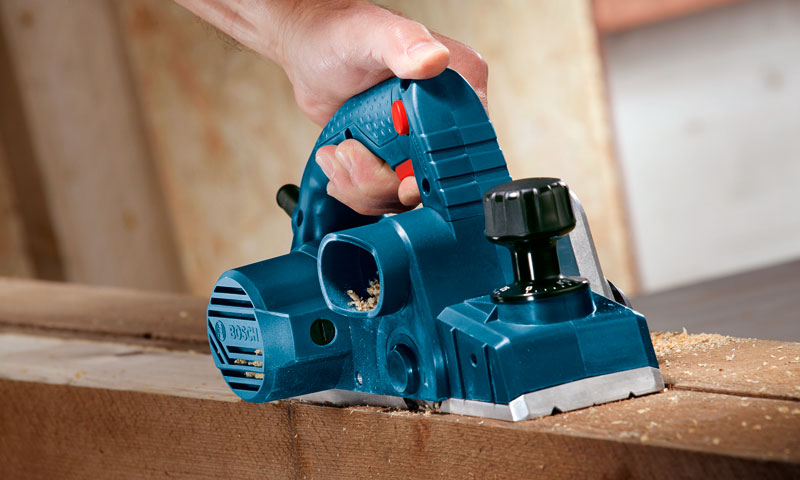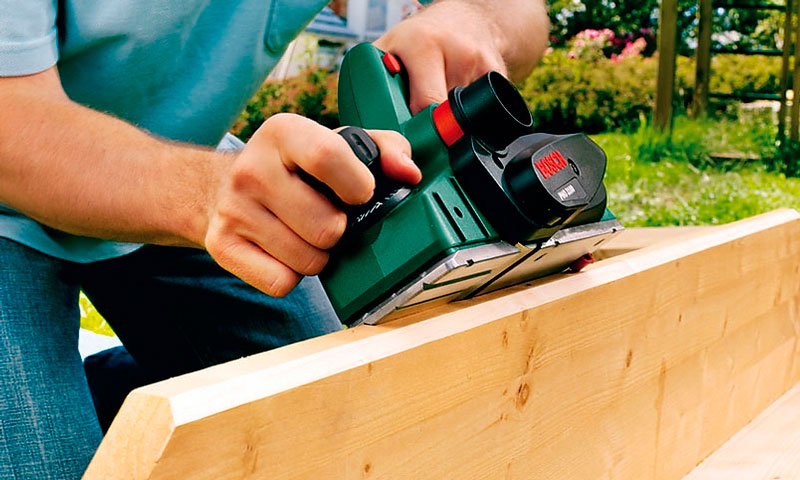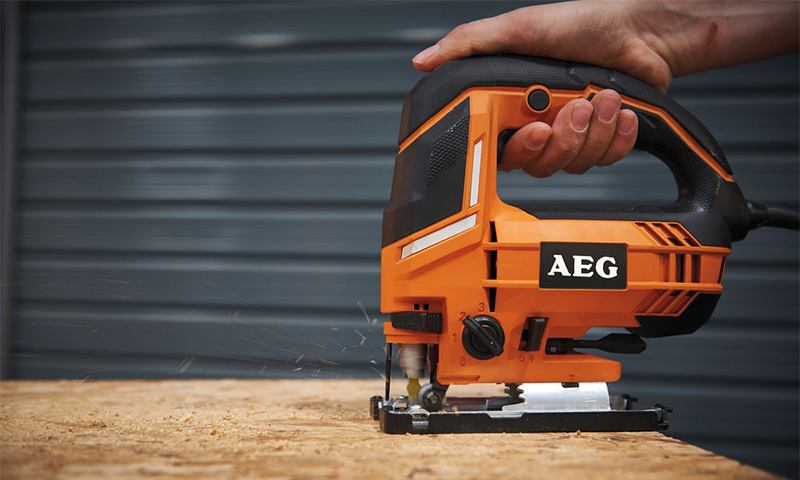Wood has always been valued in the interior. They make cabinets, tables, chairs, doors and frames. With the development of power tools, more opportunities appeared to create wooden objects of various shapes, as well as significantly increased productivity. One of these indispensable helpers is an electric plane. A similar tool is available in every professional workshop and among lovers in the garage. At the cottage with his help it is possible to make the necessary furniture and appliances in the yard. Such construction equipment contains a variety of selection options, understanding that it will be possible to purchase a tool that justifies the hopes placed on it in the implementation of tasks.

Content:
The best manufacturers of electrical planers - which company to choose
Quality construction tools traditionally have German or Japanese roots.
If you delve into all the features of electroplane laziness, you can purchase the company's products from the list below:
- Makita;
- DeWalt;
- Skil;
- Bosch;
- Hitachi.
But each of the firms represented has such a large variety of models in terms of characteristics and capabilities that it is worth looking into rating of the best electroplanes.
The key features of the power tool and its purpose for different tasks are described below.
Principle of operation and device

The electrical plane is an analogue of a conventional planer with the same purpose - removing the top layer of wood to create a perfectly flat surface.
Unlike the mechanical version, where everything depends on the magnitude of the vertical pressure from the specialist and the strength of the longitudinal reference, the electroplane itself “bites” into the solid wood and selects a certain layer due to the powerful motor and rotating knives.
With this tool you can perform:
- planing;
- quarter sampling;
- beveling edge;
- Fit wooden elements tightly to each other.
It found a display in the manufacture of tables, cabinets, window sills, chairs, benches, gazebos, bedside tables and frames. The tool is used after rough processing of wood. Usually, the trunks are unraveled at the sawmill, after which they are delivered in the form of unhewn boards or sawn bars.
Drying removes excess moisture and slightly deforms the plane. The coarse structure of the fibers and the unevenness of the wood need further refinement, which is done with an electric planer that helps to create a smooth surface.
At the final stage, the product is polished with a machine with petal circles and ready for painting or varnishing.
To ensure high-level performance, manufacturers have carefully thought out the design and internal parts of the tool.
The device electroplane includes:
1. electric motor;
2. drum with knives;
3. Belting;
4. main handle with start button;
5. auxiliary handle for uniform pressure and hold;
6.depth adjuster;
7. sole;
8. channel for chip discharge;
9. additional linear and limiting devices.
The principle of the tool is to rotate the motor from the power supply from the network. A toothed belt drive protected by a casing connects the engine with the drum. On the last blade are located with a selected angle, which cut into the plane of the surface moving in parallel.
To regulate the depth of penetration into the material there is a special base consisting of two parts - front and rear. One part of the platform is able to move up and down, and the second, with the cutting drum, remains at the same level.
The difference between the height of the parts of the ski and creates a drop for cutting in the blade and determines what depth of the tree will be planed.
During operation, the removed layer of wood in the form of small chips and dust is discharged to the side through a special channel. Some models have a bag that reduces the amount of sawdust in the air. In any case, to use the electroplane, you must wear safety glasses.
Types of electroplanes
Electrical plane for home and garden

The main criterion for distinguishing electric planes is their power. Models with a parameter from 0.5 to 1 kW are considered domestic. Their capacity is enough to perform small or one-time tasks arising in a private house or cottage.
With everyday use throughout the day, they are inefficient in terms of performance or break quickly.
Advantages:
- inexpensive;
- acceptable power up to 1 kW;
- fine depth setting;
- small weight;
- comfortable grip.
Disadvantages:
- All necessary accessories for amateur versions are not on sale;
- harder to work with hardwoods.
Professional electric planers

This group of products has a capacity from 1 to 2.2 kW. This stock allows you to quickly cope with any tasks in the woodworking industry or in a private workshop.
Professional models are practical for the manufacture of interior doors, tables, cabinets, window frames. It is convenient to process hard rock with them (oak, ash). The tool can work throughout the day and serve for a long time.
Advantages:
- high power;
- all day use;
- a large number of additional devices;
- high revs;
- depth adjustment up to 18 mm;
- very smooth surface after passage;
- wide area capture.
Disadvantages:
- expensive;
- Many models are much heavier than amateur.
Electroplane selection options

The more the buyer knows about the key parameters of the tool, the more appropriate the model will be able to choose. Consider some of them.
Machine power
This tool is available with electric motors in the range of 0.5-2.2 kW. The power of the power unit affects performance. The stronger the motor, the faster the plane can perform various manipulations.
1. If the device is purchased for periodic use and does not depend on the volume performed for the day, then it has washed to buy a model with low rates of 0.5-0.7 kW. It will save money.
2. In the professional field, the number of processed boards affects the number of products made and can slow down the whole process and affect the work of other employees, so powerful electric planes with a 1.2-1.5 kW figure are acquired here.
Processing width
The job of an electrical planer is to hold the tool along the surface. At one time, the machine processes exactly as much width as the blade and drum parameter allows. This indicator varies from 82 to 312 mm.
Models with intermediate figures of 110 and 170 mm are common. It turns out that a board with a width of 1000 mm an electric planer with a minimum value of the ski (82 mm) will process in 12 passes, and a tool with an indicator of 110 mm for 9 times. This saves time and effort.
But the presence of a wide base and the corresponding drum is justified only in the case of working with large boards, because the 150 mm beam will have to be repeated with both types of tools.
1. Skiing with 82 mm parameters is worth buying for making window frames, grinding beams, racks, chairs.
2. Wider models with a base of 110-170 mm are suitable for large products: tables, doors, cabinets.
Idle frequency
This parameter indicates how many turns in one minute will make the drum without a load on the surface. There are several blades on each rotary element. The number of revolutions shows how many times each blade touches the material, and therefore, how quickly it will be able to process it.
It is not necessary to identify the rotational speed with power, since models with the same indicator of kW are capable of a different number of revolutions. This is achieved by the details in the torque transmission system and the drum device.
The run-up frequency of idling is 12000-19000 rpm.
1. For rare use in the country is enough indicator in the 12000-13000 r / min.
2. For professional activity, you must choose a model of 15000-19000 rpm.
Sampling depth
The number of millimeters cut on the surface depends on the difference in the level of the two parts of the ski. To regulate this differential, a rotation system and adjustment knob are provided. Electrical plane can shoot from 0.1 to 18 mm, but each model has its own range.
1. A tool with a large run-up from 0.1 to 10 mm is important for those who deal only with sawn boards, perhaps with bark on the sides. By adjusting the plane to a deep level, you can quickly remove a less dense layer.
2. For those who work with an already dried board, on which it is necessary to correct the last irregularities, models with the parameter of 0.1–2 mm are sufficient.
Thanks to the electric planer, you can choose a part of the angle for a neat connection of wooden parts. It is used in the manufacture of furniture and windows.
Sometimes you have to shoot up to 10 mm to produce enough seating and install additional wooden elements, so here the depth of sampling is important and you need models with a rating of up to 4-5 mm.
The presence of grooves on the sole
The base of the electroplane going in front of the knives may contain one or more V-shaped grooves.
1. If the tool is used only for grinding a flat board (timber, beams), then you can buy a model without grooves.
2. For the manufacture of benches, table tops and windows, beautiful bevels are extremely important, making the product more accurate, so the presence of a groove on the sole is very useful.
Quarter Sample
In some models, the drum is not located in the middle, but is shifted to one of the sides of the instrument. This allows you to closely bring it to the end of the board and choose a small part, while the device case does not interfere with the execution, and an emphasis is provided on the front side of the device for holding an equal distance along the entire length of the board.
Tool weight
Electrical plane weights range from 2.5 to 9 kg. Often professional models have a large mass. In part, this helps in pressing on the product and tight fit of the tool sole. Therefore, people with low weight and poor physical fitness will be able to better treat the surface with a device with a mass of 6-8 kg.
The same parameters should be chosen by those who work throughout the day, as it is very tiresome to constantly press down on the unit from above, and in case of a heavy model, it is enough to push it along the treated surface along.
But there are works not on the table, but in an upright spatial position (grouting irregularities in an already built gazebo, bench, frame). Here it will be more convenient to work with a tool with a small weight of 2.5-3 kg. The same option is suitable for giving.
Convenience handles
This parameter is difficult to assess visually from the image in the online store, so you need to hold the product in your hands and feel the distribution of mass, balancing, ease of capture and retention.
Each electric planer is supplied with a main handle with a trigger. Pressing the latter should not be intercepted, but directly from the main position of the hand.
The auxiliary handle is appreciated with a pronounced mushroom shape, so that it can be lifted for it if necessary. The coating is preferably rubberized to easily hold the device in sweaty hands.
Dust collector
During operation, an electrical planer costs a lot of dust (wooden fiber ground with knives in the form of small sawdust and shavings). All this flies on clothes, on the floor and in the eyes. The organs of vision must be protected with glasses from small particles. After doing the work you have to clean the room for a long time.
Partially to relieve of these problems will help the dust collector, which sits on the outlet from under the knives and catches most of the garbage. This device will be especially practical for those working inside the building (workshop, workshop, garage).
Extra options
1. Some electroplanes are equipped with a parallel limiter to control the reference evenness. This is not important in simple surface grinding for doors or tabletops, but it is important if you select a quarter or remove a layer only from the edge of the board for decorative processing.
2. Included may be a small frame fixing the electroplane upside down. This is practical for processing narrow bars that the master holds in his hands, and the tool uses as a desktop machine.
3. Soft start allows you to give a gradual load from the engine to the drum. This will allow you to calmly take the tool in your hand, stand over the product and, by pressing the button, bring the ski exactly to the place where the processing started.
Which electric planer to choose

1. To work with large surfaces (production of tables, wardrobes, interior doors) will require a wide electroplane with a ski 110-170 mm and a power of 1.5 kW. The depth of removal is enough models with an indicator of 2-3 mm. The number of revolutions of at least 14,000 per minute. A mass of 5-6 kg is useful.
2. To make windows and frames you need a tool with a width of 82 mm and a power of 1.2-1.6 kW. In this kind of activity, V-shaped grooves on the ski will be very useful for removing beautiful decorative chamfers. The depth of the sample is 3-4 mm. Frequency of idling 15000 rpm
3. Those who work with hardwoods (oak, cedar, ash) need an electric planer with a power of 2.2 kW, a rubber handle and the ability to change the depth of the sample to 3 mm. A high drum rotation speed of about 18000-19000 rpm will be required. It will be convenient to operate the device with a weight of 7-9 kg.
4. For giving and periodical work on staging a fence or making a bench, a model with a power of 0.6 kW and the possibility of digging up to 4 mm is sufficient. Suitable lightweight unit up to 3 kg and 12000 revolutions per minute.
How much is an electric plane

1. For processing large surface areas, models have a cost of between 12,000 and 26,000 rubles.
2. A practical tool for the manufacture of windows and frames will cost 6000-10000 rubles.
3. Powerful models are easily coping with hard rocks and having a large mass cost over 100,000 rubles.
4. Variants of electroplanes for giving begin from 2,000 to 6,000 rubles.
It will be interesting to friends too







